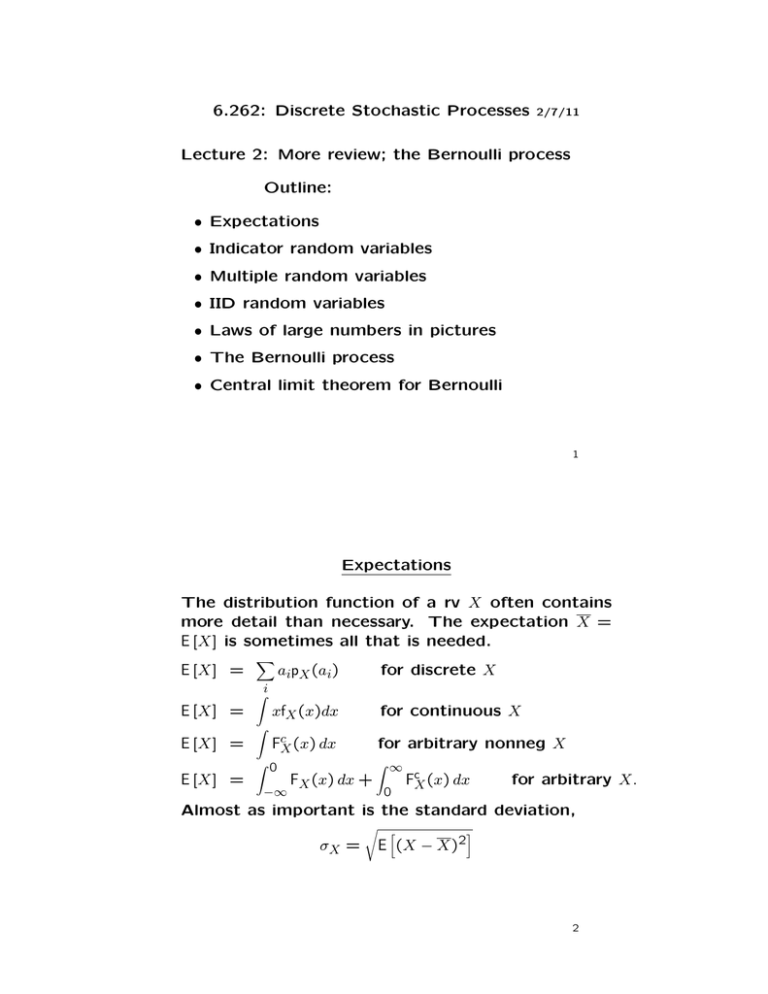Document 13687202
advertisement

6.262: Discrete Stochastic Processes
2/7/11
Lecture 2: More review; the Bernoulli process
Outline:
• Expectations
• Indicator random variables
• Multiple random variables
• IID random variables
• Laws of large numbers in pictures
• The Bernoulli process
• Central limit theorem for Bernoulli
1
Expectations
The distribution function of a rv X often contains
more detail than necessary. The expectation X =
E [X] is sometimes all that is needed.
E [X] =
E [X] =
E [X] =
E [X] =
�
�i
�
aipX (ai)
for discrete X
xfX (x)dx
for continuous X
FcX (x) dx
� 0
−∞
for arbitrary nonneg X
FX (x) dx +
� ∞
0
FcX (x) dx
for arbitrary X.
Almost as important is the standard deviation,
σX =
� �
E (X − X)2
�
2
�
Why is E [X] = FcX (x) dx for�
Look at discrete case. Then
arbitrary nonneg X?
�
FcX (x) dx = i aipX (ai).
a1
pX (a1) a1pX (a1)
pX (a2)
✈
a2
a2pX (a2)
pX (a3)
✈
a3
FcX (x)
a3pX (a3)
pX (a4)
✈
a4pX (a4)
a4
✈
If X has a density, the �same argument applies to
every Riemann sum for x xfX (s) dx and thus to the
limit.
�
It is simpler and more fundamental to take FcX (x) dx
as the general definition of E [X]. This is also useful
in solving problems
3
Indicator random variables
For every event A in a probabiity model, an indicator
rv IA is defined where IA(ω) = 1 for ω ∈ A and IA(ω) =
0 otherwise. Note that IA is a binary rv.
pIA (0) = 1 − Pr{A} ;
pIA (1) = Pr {A} .
�
FIA
1 − Pr{A} �
0
E [IA] = Pr{A}
1
σIA =
1
�
0
Pr {A} (1 − Pr {A})
Theorems about rv’s can thus be applied to events.
4
Multiple random variables
Is a random variable (rv) X specified by its distribu­
tion function FX (x)?
No, the relationship between rv’s is important.
�
FXY (x, y) = Pr {ω : X(ω) ≤ x}
�
The rv’s X1, . . . , Xn are independent if
FX
� (x1, . . . xn) =
n
�
FXm (xm)
�
{ω : Y (ω) ≤ y}
for all x1, . . . , xn
m=1
This product form carries over for PMF’s and PDF’s.
5
For discrete rv’s, independence is more intuitive
when stated in terms of conditional probabilities.
pX|Y (x|y) =
pXY (x, y)
pY (y)
Then X and Y are independent if pX |Y (x|y) = pX (x)
for all sample points x and y. This essentially works
for densities, but then Pr{Y = y} = 0 (see notes).
This is not very useful for distribution functions.
NitPick: If X1, . . . , Xn are independent, then all sub­
sets of X1, . . . , Xn are independent. (This isn’t al­
ways true for independent events).
6
IID random variables
The random variables X1, . . . , Xn are independent
and identically distributed (IID) if for all x1, . . . , xn
FX
� (x1, . . . , xn) =
n
�
FX (xk )
k=1
This product form works for PMF’s and PDF’s also.
Consider a probability model in which R is the sam­
ple space and X is a rv.
We can always create an extended model in which
Rn is the sample space and X1, X2, . . . , Xn are IID
rv’s. We can further visualize n → ∞ where X1, X2, . . .
is a stochastic process of IID variables.
7
We study the sample average, Sn/n = (X1+ · · · +Xn)/n.
The laws of large numbers say that Sn/n ‘essentially
becomes deterministic’ as n → ∞.
If the extended model corresponds to repeated ex­
periments in the real world, then Sn/n corresponds
to the arithmetic average in the real world.
If X is the indicator rv for event A, then the sample
average is the relative frequency of A.
Models can have two types of difficulties. In one,
a sequence of real-world experiments are not suffi­
ciently similar and isolated to correspond to the IID
extendied model. In the other, the IID extension is
OK but the basic model is not.
We learn about these problems here through study
of the models.
8
Science, symmetry, analogies, earlier models, etc.
are all used to model real-world situations.
Trivial example: Roll a white die and a red die.
There are 36 sample outcomes, (i, j), 1 ≤ i, j ≤ 6,
taken as equiprobable by symmetry.
Roll 2 indistinguishable white dice. The white and
red outcomes (i, j) and (j, i) for i =
� j are now in­
distinguishable. There are now 21 ‘finest grain’
outcomes, but no sane person would use these as
sample points.
The appropriate sample space is the ‘white/red’
sample space with an ‘off-line’ recognition of what
is distinguishable.
Neither the axioms nor experimentation motivate
this model, i.e., modeling requires judgement and
common sense.
9
Comparing models for similar situations and analyz­
ing limited and defective models helps in clarifying
fuzziness in a situation of interest.
Ultimately, as in all of science, some experimenta­
tion is needed.
The outcome of an experiment is a sample point,
not a probability.
Experimentation with probability requires multiple
trials. The outcome is modeled as a sample point
in an extended version of the original model.
Experimental tests of an original model come from
the laws of large numbers in the context of an ex­
tended model.
10
Laws of large numbers in pictures
Let X1, X2, . . . , Xn be IID rv’s with mean X, variance
2 = nσ 2.
σ 2. Let Sn = X1 + · · · + Xn. Then σS
n
1 ·
·
·
·
·
·
·
·
·
·
·
·
·
·
·
·
·
· (Bernoulli
· · ·
case)
·
· ·
F
· S20
·
·
0.6 ·
· ·
FS4
· ·
·
·
·
F
· S50
· ·
0.4 ·
·
·
·
·
·
·
·
·
·
·
0.2
·
·
·
·
·
·
·
·
·
·
·
· · ·
pX (1) = 1/4
· · · ·
pX (0) = 3/4
· · · ·
15
20
0.8 ·
0
5
10
·
·
·
The center of the distribution varies with n and the
√
spread (σSn ) varies with n.
11
The sample average is Sn/n, which is a rv of mean
X and variance σ 2/n.
1·
·
·
·
·
·
·
·
·
·
·
·
·
0.8 ·
· ·
FSn/n(z)
0.6 ·
· ·
·
·
·
·
·
·
·
·
·
·
·
·
·
·
·
·
·
·
·
0.4 ·
·
·
·
·
·
·
·
·
·
·
0.2 ·
·
·
·
·
·
·
·
·
·
·
0
0
·
0.25
0.5
0.75
n=4
n = 20
n = 50
·
·
·
1
The center of the distribution is X and the spread
√
decreases with 1/ n.
12
Note that Sn − nX is a zero mean rv with variance
nσ 2. Thus Sn√−nX
is zero mean, unit variance.
nσ
1·
·
·
·
·
·
·
·
0.8·
· · · · ·
FZn (z)
0.6·
· · ·S −E·[S ] ·
Zn = nσX √nn
0.4·
· · · · ·
·
·
·
·
·
·
·
·
·
·
·
·
·
·
·
·
·
·
·
·
·
0.2·
·
·
·
·
·
·
·
·
·
·
·
·
·
·
0
·
−2
−1
Central limit theorem:
�
�
Sn − nX
lim Pr
≤y
√
n→∞
nσ
0
��
1
·
·
n=4
n = 20
n = 50
·
·
2
�
� y
1
−x2
√ exp
=
2
−∞ 2π
�
dx.
13
The Bernoulli process
Sn = Y1 + · · · Yn
pY (1) = p > 0,
pY (0) = 1 − p = q > 0
The n-tuple of k 1’s followed by n − k 0’s has prob­
ability pk q n−k .
Each n tuple with k ones has this same probability.
For p < 1/2, pk q n−k is largest at k = 0 and decreasing
in k to k = n.
� �
There are n
k n-tuples with k 1’s. This is increasing
in k for k < n/2 and then decreasing. Altogether,
�n�
pSn (k) =
pk q n−k
k
14
�n�
pk q n−k
k
To understand how this varies with k, consider
pSn (k) =
pSn (k+1)
n!
k!(n−k)! pk+1q n−k−1
=
pSn (k)
(k+1)!(n−k−1)!
n!
pk q n−k
n−k p
k+1 q
This is strictly decreasing in k. It also satisfies
=
<1
(k+1)
for
for
for
pSn
≈ 1
pSn (k)
> 1
k ≥ pn
k < pn < k + 1
k + 1 ≤ pn
15
pSn (k+1)
n−k p
=
pSn (k)
k+1 q
<1
(k+1)
pSn
≈ 1
pSn (k)
> 1
for
for
for
(1)
k ≥ pn
k < pn < k + 1
k + 1 ≤ pn
pn
−2
−1
0
1
2
3
k − �pn�
In other words, pSn (k), for fixed n, is increasing with
k for k < pn and decreasing for k > pn.
16
CLT for Bernoulli process
pSn (k+1)
n−k p
=
pSn (k)
k+1 q
We now use this equation for large n where k is rel­
atively close to pn. To simplify the algebra, assume
pn is integer and look at k = pn + i for relatively
small i. Then
�
pSn (pn + i + 1)
n−pn−i p
nq − i
p
=
=
pSn (pn + i)
pn+i+1 q
pn + i + 1 q
i
1 − nq
=
1 + i+1
np
p (pn + i + 1)
ln Sn
pSn (pn + i)
�
�
�
�
i
i+1
= ln 1−
− ln 1+
nq
np
�
17
Recall that ln(1 + x) ≈ x − x2/2 + · · · for |x| << 1.
�
p (pn + i + 1)
ln Sn
pSn (pn + i)
�
�
�
�
i
i+1
− ln 1+
= ln 1−
nq
np
i
i
1
= −
−
−
+ ···
nq np np
i
1
= −
−
+ ···
npq np
�
where we have used 1/p + 1/q = 1/pq and the ne­
glected terms are of order i2/n2.
This says that these log of unit increment terms
are essentially linear in i. We now have to combine
these unit incremental terms.
18
�
�
p (pn + i + 1)
i
1
−
ln Sn
=−
+ ···
npq np
pSn (pn + i)
Expressing an increment of j terms as a telescoping
sum of j unit increments,
�
p (pn + j)
ln Sn
pSn (pn)
�
�
�
pSn (pn + i + 1)
pSn (pn + i)
�j−1
i
1
−
−
+ ···
=
i=0 npq
np
j(j − 1)
j
−j 2
= −
−
+ ··· ≈
2npq
np
2npq
where we have used the fact that 1 + 2 + · · · + j − 1 =
j((j − 1)/2. We have also ignored terms linear in j
since they are of the same order as a unit increment
in j.
�j −1
ln
=
i=0
19
Finally,
�
p (pn + j)
ln Sn
pSn (pn)
�
≈
−j 2
2npq
�
−j 2
pSn (pn + j) ≈ pSn (pn) exp
2npq
�
This applies for j both positive and negative, and
is a quantized version of a Gaussian distribution,
with the unknown scaling constant pSn (pn). Choos­
ing this to get a PMF,
�
�
1
−j 2
pSn (pn + j) ≈ √
exp
,
2πnpq
2npq
which is the discrete PMF form of the central limit
theorem. See Section 1.5.3 for a different approach.
20
MIT OpenCourseWare
http://ocw.mit.edu
6.262 Discrete Stochastic Processes
Spring 2011
For information about citing these materials or our Terms of Use, visit: http://ocw.mit.edu/terms.




